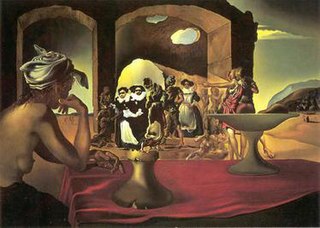 W
WApparatus and Hand is a 1927 painting by Salvador Dalí. The painting currently resides at the Salvador Dalí Museum in St. Petersburg, Florida. This work is on loan from the collection of Mr. and Mrs. A Reynolds Morse.
 W
WThe Basket of Bread is a painting by Spanish surrealist Salvador Dalí. The painting depicts four pieces of bread with butter on them sitting in a basket. One is separated from the others and is half-bitten. The basket sits on a white cloth. The painting resides at the Salvador Dalí Museum, St. Petersburg, Florida.
 W
WThe Discovery of America by Christopher Columbus is a painting by artist Salvador Dalí, begun in 1958 and finished in 1959. It is over 14 feet tall and over 9 feet wide, one in a series of large paintings Dalí did during this era.
 W
WLa Desintegración de la Persistencia de la Memoria or The Disintegration of the Persistence of Memory is an oil on canvas painting by the Spanish surrealist Salvador Dalí. It is a 1954 re-creation of the artist's famous 1931 work The Persistence of Memory, and measures a diminutive 25.4 × 33 cm. It was originally known as The Chromosome of a Highly-coloured Fish's Eye Starting the Harmonious Disintegration of the Persistence of Memory, and first exhibited at the Carstairs Gallery in New York in 1954.
 W
WThe Ecumenical Council is a surrealist painting by Spanish artist Salvador Dalí completed in 1960. It is one of his masterpieces, taking two years to complete and very large at 299.7 by 254 centimetres. The painting is a complex assemblage of art historical references and religious scenes emphasizing Catholic symbolism.
 W
WThe First Days of Spring (1929) is a painting by the Spanish surrealist Salvador Dalí. This is probably the most famous example of Dalí's early surrealist work.
 W
WGalacidalacidesoxiribunucleicacid is a 1963 painting by Salvador Dalí. The painting's title is a portmanteau of the name of Dalí's wife, Gala Dalí, and deoxyribonucleic acid (DNA). It is a tribute to Francis Crick and James D. Watson, who determined the double helical structure of DNA in 1953.
 W
WGeopoliticus Child Watching the Birth of the New Man is a 1943 painting by Salvador Dalí. The painting was done during Dalí's stay in the United States during 1940 to 1948. It is said to be one of the most recognisable paintings by him. It is of a man scrambling out of an egg while a mother and her son watch, pointing.
 W
WThe Ghost of Vermeer of Delft Which Can Be Used As a Table is a small Surrealist oil painting by Salvador Dalí. Its full title is The Ghost of Vermeer of Delft Which Can Be Used as a Table . It makes reference to The Art of Painting by Johannes Vermeer, a famous seventeenth-century work in which a painter, thought to be a self-portrait of Vermeer, is depicted with his back to us, in distinctive costume. It is one of a number of paintings expressive of Dalí's enormous admiration for Vermeer.
 W
WThe Hallucinogenic Toreador is a 1969–1970 multi-leveled oil painting by Salvador Dalí which employs the canons of his particular interpretation of surrealist thought. It is currently being exhibited at the Salvador Dalí Museum in St. Petersburg, Florida.
 W
WLandscape Near Figueras (1910) is a painting by the Spanish artist Salvador Dalí. This is one of the earliest known works by Dalí, having been painted when he was about six years old.
 W
WLincoln in Dalivision is an original limited edition lithograph created by Salvador Dalí. It is often considered one of the most counterfeited Dalí lithographs. Dalí authentication experts who have noted the counterfeiting issue with this work include Albert Field, Frank Hunter, Robert Descharnes and Bernard Ewell. Lee Catterall comments in his book The Great Dalí Art Fraud & other deceptions, "The painting most commonly reproduced for such fraudulent purposes was Lincoln in Dalivision, 'prints' of which Los Angeles art appraiser Dena Hall testified in the Hawaii trial have become as commonplace as 'pancakes at the pancake house.'"
 W
WLiving Still Life is a painting by the artist Salvador Dalí. Dali painted this piece during a period that he called "Nuclear Mysticism". Nuclear Mysticism is composed of different theories that try to show the relationships between quantum physics and the conscious mind. The different theories are composed of elements that range from "Catalan philosophers” to "classicism, pop art, and nuclear physics". The painting, done in 1956, currently resides at the Salvador Dali Museum in St. Petersburg, Florida.
 W
WMorphological Echo is a title shared by two oil-on-panel paintings created by the Spanish surrealist Salvador Dalí.
 W
WSlave Market with the Disappearing Bust of Voltaire (1940) is a painting by Spanish Surrealist Salvador Dalí. The painting depicts a slave market, while a woman at a booth watches the people. A variety of people seem to make up the face of Voltaire, while the face seems to be positioned on an object to form a bust of Voltaire. Voltaire was a French writer and philosopher known for his opposition to slavery.